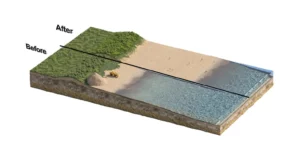Ike Dike Project Secures Initial Federal Funding
Adam Zuvanich, Houston Public Media
A recent $500,000 allocation to the U.S. Army Corps of Engineers will be used for preconstruction engineering and design work on a segment of the Coastal Texas Project, also known as the Ike Dike. The long-planned initiative is expected to take about 20 years to construct and cost an estimated $57 billion.
The long-planned Ike Dike project has its first bit of federal funding – a small fraction of the money needed to construct the multifaceted coastal barrier system that would help protect the Houston region and its petrochemical industry from the impacts of a powerful hurricane.
The U.S. Army Corps of Engineers was allocated $500,000 this month for preconstruction engineering and design work on a segment of its Coastal Texas Project, known locally as the “Ike Dike” because the plan was hatched after Hurricane Ike devastated the Houston and Galveston areas in 2008. The multibillion-dollar project was authorized by Congress in 2022 but had yet to receive any federal funding, with the House Appropriations Committee last year denying a $100 million funding request made by U.S. Rep. Randy Weber, a Republican whose district includes Galveston.
The Ike Dike project is estimated to take about 20 years to construct with a projected total cost of about $57 billion, factoring in inflation, according to the Army Corps. The federal government is slated to cover 65% of the cost, with the rest potentially coming from the state of Texas and/or local tax revenue that would need to be authorized by voters in impacted counties.
“It is imperative that we get the Coastal Texas Project completed as soon as possible, ideally before the next big storm comes barreling at the upper Texas Gulf Coast, and this is a great step in the right direction,” Weber said in a statement about the $500,000 allocation. “The Texas Gulf Coast is home to millions of people, countless homes and jobs, and numerous refineries. I remain steadfast in my commitment to championing this project in Washington.”
The Army Corps and Texas General Land Office spent six years and about $20 million on a feasibility study for the Ike Dike project, which was the basis for Congress’ authorization. The plan calls for constructing a series of 22-foot-tall gates between Galveston Island and Bolivar Peninsula, which serves as the entryway into the Houston Ship Channel, along with additional gate systems in Clear Lake and Dickinson Bay, breakwaters, beach-and-dune systems on Bolivar and Galveston, a ring barrier on the bay side of the island and a raising of the Galveston seawall.
The $500,000 funding allocation, from the U.S. Army Civil Works Program Fiscal Year 2024 Work Plan, will be devoted specifically to preparing breakwaters for construction, according to the Army Corps. That part of the project entails building permanent structures to provide shoreline and island protections on the Bolivar Peninsula, which is just east of Galveston, and the north shore of West Bay, which is north of the island’s west side.
The start of construction for the breakwaters would be determined by additional federal funding. A spokesperson for the Army Corps said finalizing its design would prepare the project “to compete for federal construction funding starting in 2025.”
“Projects of this scale and magnitude require ongoing funding and long-term partner collaboration, but we cannot discount the critical importance (of) quickly moving forward with the design and construction of initial segments of this transformational project,” said Gulf Coast Protection District president Michel Bechtel.
The Army Corps will conduct engineering and design work in collaboration with the Texas General Land Office and the Gulf Coast Protection District, which is the non-federal sponsor of the Ike Dike project. The district was created by the Texas Legislature in 2021 and contains more than 5,200 square miles of land covering Chambers, Galveston, Harris, Jefferson and Orange counties.
The Texas Legislature last summer allocated $550 million toward the Ike Dike project and a similar initiative, through a general appropriations bill, and previously authorizing $400 million for the project.
“The Coastal Texas Project is one of the largest projects in the history of the U.S. Army Corps of Engineers,” said Col. Rhett A. Blackmon, the commander of the Army Corps’ Galveston District. “This project is important to the nation for many reasons. Not only will it reduce risk to the vulnerable populations along the Texas coast, but it will also protect vital ecosystems and economically critical infrastructure vital to the U.S. supply chain and the many global industries located here.”
